New York State Police 
New York State Police 
The New York State Police was founded on April 11, 1917 in response to an outcry from a lack of policing in rural areas of the state. The first of the original 237 officers and men began training at a National Guard Camp in Manlius, New York.
The NYSP's first Superintendent George F.Chandler M.D., christened the training facility Camp Newayo, in honor of Ms. Newell and Ms. Mayo, the two Westchester County women who advocated so ardently and are credited for the impetus to form the NYSP. Although established initially as a mounted police force, the State Police quickly realized the value of the automobile.
In 1918 they added Model T Fords to their equipment and also purchased three motorcycles per Troop. Enforcement of vehicle and traffic laws became an increasingly important part of the Troopers' duties. Troopers gradually assumed more responsibility for vehicle and traffic safety, taking over all motor vehicle enforcement from the Motor Vehicle Bureau in 1926. Seventeen men were added to each Troop because of the new duties, bringing the authorized strength to 584, more than double the original complement.
In 1928, the State Police began policing the parks and parkways on Long Island for the first time, the beginning of what came to be informally known as "Troop L." The number of automobiles and motorcycles also increased and, in 1929, 112 Troopers on motorcycles were assigned full time to traffic enforcement duty. During the 1930s vehicle and traffic enforcement became an increasingly important part of the Troopers' duties.
In 1937, the first Traffic Bureau was established. It was in 1937, too, that the first formal course in Vehicle and Traffic enforcement was included in the curriculum of the State Police School. Although mounted patrols would continue throughout the decade, the number of miles covered on horseback would steadily decline and, in 1935, would fall below 50,000 miles for the first time in the History of the Division. In 1934, the first Diving Unit was established, and a Truck and Bus Squad was created to enforce commercial vehicle laws and check for overloaded trucks.
The end of World War II and the resurgence of highway traffic tolled the death knell for one of the oldest State Police traditions, as well. Mounted patrol miles had declined steadily throughout the 1930s and early 1940s. In 1947, only 2,115 miles were patrolled on horseback, less than 1/100th of the number 30 years before. In 1948, for the first time in its History, the New York State Police did not report any mounted patrols. Another major change was the opening, in 1954, of the New York State Thruway.
The New York State Police assumed sole responsibility for policing the Thruway and its authorized strength was increased from 899 to 1201 members in 1953 in order to provide the additional Thruway patrols. Troop cars also got a new look. In 1955 the gray patrol cars were replaced by new black and whites. In the same year patrol cars on the Thruway were painted blue and cream and, for the first time, had sirens and flashing red lights installed on the roof.
Three new Troops were authorized. The Thruway Detail was officially designated Troop T in 1961. In 1967, Troop E began operating from its new headquarters in Canandaigua, and Troop F began operations the following year. On January 1, 1980, the New York State Police took over responsibility for policing the Long Island Parkway and three shorter parkways upstate. The Parkway Police who were providing these services were absorbed into the New York State Police. Troop L Headquarters relocated from Islip Terrace to a new Headquarters Facility in Farmingdale.
In addition to direct police services, the New York State Police developed a wide range of sophisticated investigative and support services during the 1980s that are available to law enforcement agencies across the State to assist them in their police activities. These include Violent Criminal Investigative Services, computerized databases and analyses, forensic laboratory services, access to specialists in forensic sciences, mobile response teams and training. These are provided in addition to services established in earlier decades such as Hazardous Materials Specialists, Canine Units, Aviation and divers.
The New York State Police continues its tradition of cooperating with, assisting and supporting local and county law enforcement agencies across the Empire State.
Early photographs from the formation of the NYSP indicate that what few cars they had, all used the standard New York passenger car license plates in the 123-123 numbering format.
Of particular interest though, is a photograph from 1920 seen further below, which shows what appears to be a flat-painted license plate-sized sign with the words N.Y. STATE over POLICE hung on the radiator of a NYSP open touring car. This "sign plate" was used in addition to a standard contemporary New York passenger license plate. It is not believed that these titled signs were a general issue as other patrol cars seen in the same photograph only bear the regular passenger license plates as seen in other such photos from the same time period. Either way, this titled NY STATE POLICE "sign plate" is the earliest example (so far) of an agency-specific "license plate" used by a state law enforcement agency anywhere in the USA.
The "sign plate" was dropped until the mid to late 1930's where a similar sign plate was used in conjunction with the reserved series passenger plates as seen in the 1937 on-duty photo shown further down below. These special worded title sign plates were confirmed in use at Troop K's Fishkill Post, but it is unknown if they were in use elsewhere in the state at that time.
Confirmed license plate numbers used by the NYSP for 1920 besides the ones seen below are, 675-327, 730-145, 730-501 and 730-844.

 Passenger series. Embossed steel. 6" x 16 1/8" White over olive green |
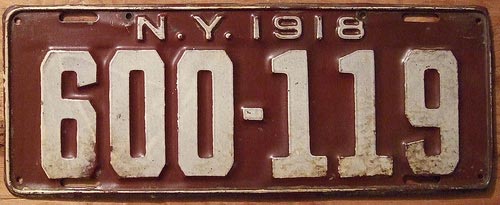 Passenger series. Embossed steel. 6" x 16 1/8" White over maroon |
 Passenger series. Embossed steel. 6" x 16 1/8" White over black |
 Circa 1917-1920's NYSP "sign plate". White and green porcelain enamel over steel. Measuring approximately 6 " x 15".
Circa 1917-1920's NYSP "sign plate". White and green porcelain enamel over steel. Measuring approximately 6 " x 15".
(Courtesy Gene Haumann)
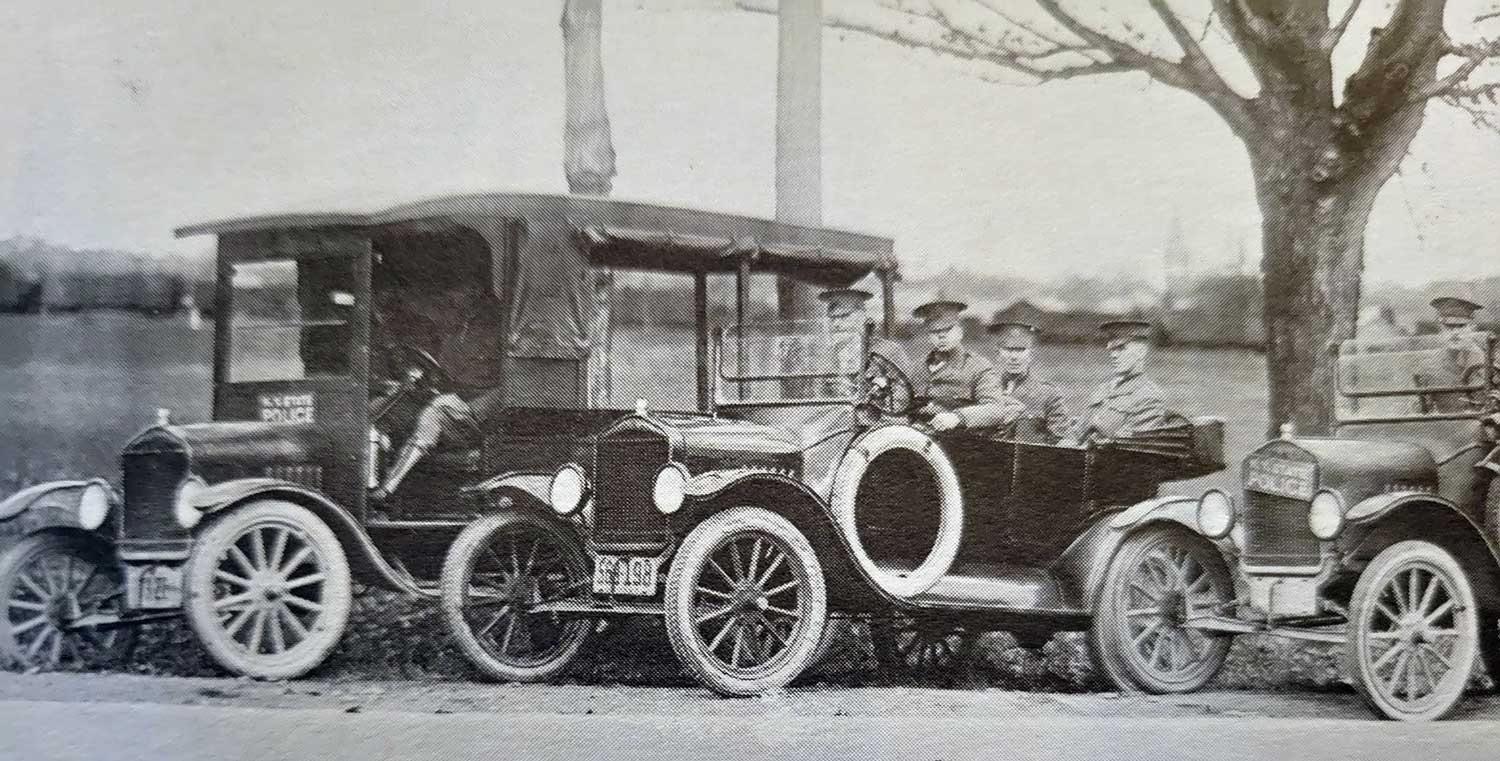
 1920. Car in center displays "N.Y. STATE POLICE" sign plate on radiator. This is the earliest known "state police license plate" anywhere in the USA. Note that the other NYSP cars in the photo do not have the NYSP sign plate affixed. Thus it can be determined that these sign plates were not a general issue throughout the NYSP.
1920. Car in center displays "N.Y. STATE POLICE" sign plate on radiator. This is the earliest known "state police license plate" anywhere in the USA. Note that the other NYSP cars in the photo do not have the NYSP sign plate affixed. Thus it can be determined that these sign plates were not a general issue throughout the NYSP.
(Courtesy Kevin Enser)
 1920. Use of six-digit, all-numeric passenger license plates.
1920. Use of six-digit, all-numeric passenger license plates.
(Courtesy Kevin Enser)
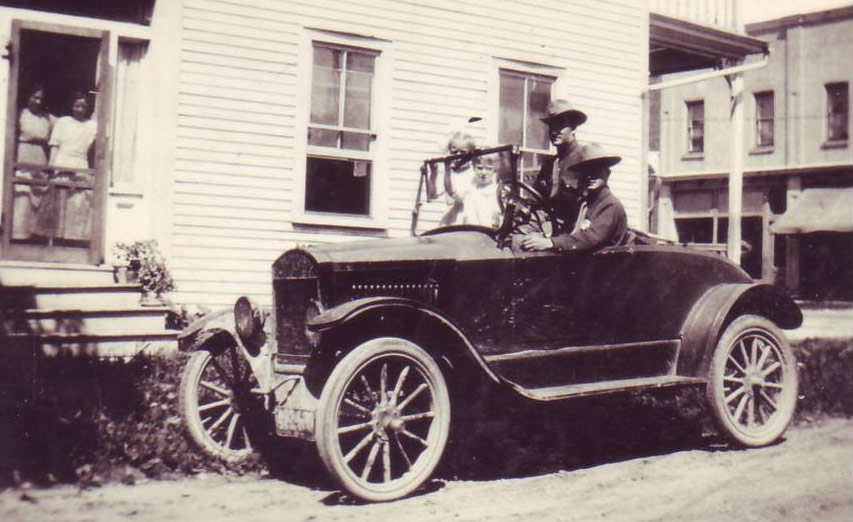 1921. Lt. George Homer Harrison
1921. Lt. George Homer Harrison
(Courtesy Kevin Enser)
 Passenger series. Embossed steel. 6" x 16 1/8" White over pale green |
 Passenger series. Embossed steel. 6" x 16 1/8" White over midnight blue |
 Passenger series. Embossed steel. 6" x 16 1/8" White over emerald green |
Although it is not known for certain, it is believed that random-numbered, mostly six-digit passenger license plates were used for one more year in 1921 on NYSP motor cars. The size was still the same as the previous issues but N.Y. 1921 was situated at the bottom center of the plate. The color scheme was white over midnight blue.
Prior to the December of 2021, it was believed that the earliest reserved series license plates for the NYSP began in 1924. This was based on photographic evidence provided by Retired NYSP Sgt Kevin Enser that showed that the NYSP began using license plates in the 900 series for their patrol cars at least by that year. The plates bore the same size, color and format as the contemporary passenger car plates, however with a number in the 900 series centered in the middle of the plate.
Annually-issued license plates in New York state at that time allowed from number 1 to 2500 to fall as a "Reserved Series" and were only issued to individuals or groups with "clout" in the state.
The 1924 photo seen below depicting a garage scene from Troop A (Batavia) shows conclusively that New York State Police were issued license plates in the 900 series. The photo shows plate number 932 on what would be a 1924 New York license plate colored white over French gray. Unfortunately, officer Tryon at the right hand side of the photo is standing directly in front of the other car facing the camera, thus obscuring the plate from view.
These 900 series plates do not appear hyphenated on the 1924 base, however subsequent years show a hyphen between the 9 and the latter two numbers.
HOWEVER! In December of 2021, the writer received contact from a fellow license plate collector in New york state where a scan of his collection revealed a very interesting and likely groundbreaking specimen. A rough, but presentable and very legible 1922 New York license plate number 989. The plate had most of its paint gone from years of oxidation, but remnants of the emerald green background paint could be seen poking up to the top of the numbers. The collector went on to say that he had purchased the low-number plate from someone that had it along with 1922 plate # 987. Another collector was know to have made a similar recent purchase for # 986. This was a high indicator that these three 100+ year old license plates were from a fleet in one area. Making it very likely that New York State Police was running the 900 reserved series license plates as early as 1922.
 1922 900 Reserved Series.
1922 900 Reserved Series.  900 Reserved Series.
900 Reserved Series. 
The 1925 photo seen below shows the same license number (932) as seen in the 1924 photo above, however this issue shows the use of the hyphen between the 9 and 32. This formatting for NYSP reserved numbers continued for the next 30 years, covering numbers in the 9-##, 10-##, 11-##, 12-## etc...series.

1925 issue- Black over yellow. Showing hyphenated 900 series plate used by NYSP at the time.
F/Sgt. Brandstetter and colleagues.
(Courtesy Kevin Enser)
1926 NYSP license plates were made of embossed steel measuring 6 1/8" x 16" with N.Y. 1926 embossed at bottom center and colored white over dark blue. Reserved number in the 9-## series.

1927 issue- Black over deep yellow.
Trooper James T. Linehan- Webster NY
(Courtesy Kevin Enser)
1928 NYSP license plates were made of embossed steel measuring 6 1/8" x 16" with NY 28 embossed at bottom center and colored deep yellow over black. Reserved number in the 9-## series.

1929 issue seen at far left (976). Embossed steel measuring 6 3/8" x 13 1/2" with NY-29 embossed at bottom center and number in the 9## series (appears that there is no dash) and possibly commenced the 10-## series elsewhere in the state by this time.
(Courtesy Kevin Enser)

1929
(Courtesy Allan Attanasio)
1930 NYSP license plates were made of embossed steel measuring 6 1/4" x 13 1/2" with NY 30 embossed at top center and colored deep yellow over black.
Reserved number in the 9-## and 10-## series.
 1931 issue. Embossed steel.
1931 issue. Embossed steel. 

1931 issue- Black over deep yellow in 11-## series.
(Courtesy Kevin Enser)
 1932 NYSP license plates were made of embossed steel measuring 6 3/8" x 13 5/8" with NY 32 embossed at top center and colored deep yellow over black.
1932 NYSP license plates were made of embossed steel measuring 6 3/8" x 13 5/8" with NY 32 embossed at top center and colored deep yellow over black.
Reserved number in the 9 ##, 10-## and 11-## series.
 1933 issue- Black over deep yellow in 11-## series.
1933 issue- Black over deep yellow in 11-## series.
Photo taken during 1933 Milk Strike.
(Courtesy Kevin Enser)

1933- Truck Inspection.
(Courtesy Kevin Enser)
1934 NYSP license plates were made of embossed steel measuring 6 3/8" x 13 5/8" with NY 34 embossed at bottom center and colored deep yellow over black. Reserved number in the 9-##, 10-## and 11-## series.
 1934 issue. Embossed steel.
1934 issue. Embossed steel. 
 1935 issue. Embossed steel.
1935 issue. Embossed steel. 

1936 NYSP license plates were made of embossed steel measuring 6 1/4" x 13 1/2" with NY 36 embossed at top center and colored deep yellow over black. Reserved number in the 9-##, 10-## and 11-## series.


1937 NYSP license plates were made of embossed steel measuring 6 1/4" x 13 1/2" with NY 37 embossed at top center and colored black over deep yellow. Reserved number in the 9-##, 10-##, 11-## and 12-## series.
As seen in photo above at left, a titled STATE POLICE plate with light characters over a dark background was also used, but likely not a force-wide issue.

July 25 1937-Walter Erickson and Thomas Woods at Troop L
(Northern State Parkway Barracks).
Adjusting "fish pole antenna" on one of the first all-white NYSP Troop cars.

1937- with John Millman and Walt Crusen
(Courtesy Kevin Enser)
In 1938, the Empire State was preparing to host the World's Fair Exposition which was to take place in New York City the following year. In anticipation of this important event, New York state issued their first "slogan" license plate announcing the upcoming occasion.
The license plates were once again made of embossed steel and measuring 6 1/4" x 13 1/2". The paint scheme was deep yellow over black. The top center of the plate had N.Y. 38 embossed. Along the entire bottom span of the plate, just above the mounting holes was embossed NEW YORK WORLD'S FAIR 1939. NYSP numbers were still allotted the reserved number series 9-##, 10-##, 11-## and 12-##.

1938. Deep yellow over black "NEW YORK WORLD'S FAIR 1939" along bottom of plate.
(Courtesy Norman Rhoades)

Road flare- 1938. Same patrol car as featured above (10-44)
(Courtesy Frank Goderre)

1938. Deep yellow over black "NEW YORK WORLD'S FAIR 1939" along bottom of plate.
(Courtesy Kevin Enser)

1938. Deep yellow over black "NEW YORK WORLD'S FAIR 1939" along bottom of plate.
(Courtesy Kevin Enser)
1939 ushered in the New York's hosting year for the World's Fair. As a result, the promotion of the event continued on Empire State license plates for the year.
The license plates were once again made of embossed steel and measuring 6 1/4" x 13 1/2". The paint scheme was black over deep yellow. The top center of the plate had NEW YORK WORLD'S FAIR 1939 embossed just below the upper mounting holes. NYSP numbers were still allotted the reserved number series 9-##, 10-##, 11-## and 12-##.

1939. Black over deep yellow. "NEW YORK WORLD'S FAIR 1939" along top of plate.
(Courtesy Kevin Enser)

1939. Black over deep yellow. "NEW YORK WORLD'S FAIR 1939" along top of plate.
Note car at far left with a STATE POLICE title plate by the right fender.
(Courtesy Kevin Enser)
The highly-successful 1939 New York World's Fair ran a second Summer of events in 1940 and thus the promotion of the Fair continued on New York's 1940 license plates as well.
The license plates were once again made of embossed steel and measuring 6 1/4" x 13 1/2". The paint scheme was deep yellow over black. Along the entire bottom span of the plate, just above the mounting holes was embossed NEW YORK WORLD'S FAIR 1940. NYSP numbers were still allotted the reserved number series 9-##, 10-##, 11-## and 12-##.

1940. Deep yellow over black. "NEW YORK WORLD'S FAIR 1940" along bottom of plate.
(Courtesy Kevin Enser)

1940 (Courtesy Mark Scarselli)
In 1941, New York license plates went back to being subdued and non-descript.
The license plates were once again made of embossed steel and measuring 6 1/4" x 13 1/2". The paint scheme was black over deep yellow. NY 41 was embossed at the bottom center of the plate. NYSP numbers were still allotted the reserved number series 9-##, 10-##, 11-## and 12-##.

1941. Black over deep yellow.
(Courtesy Al Kurek)
 1942 issue. Embossed steel.
1942 issue. Embossed steel. 
As America's role in the Second World War continued on, the need to conserve metal was a large undertaking to assist in the War Effort. As a result, no full-sized license plates were made or issued in New York for the year 1943.
Instead, a 1 5/8" x 10" embossed steel strip with only NY 43 embossed in black over deep yellow was issued to be placed over the top portion of the 1942 license plate to show validation for 1943.

In 1944, black over deep yellow license plates were issued, many of them being struck on unissued 1942 base plates. These can be seen where the last 4 of 44 can be seen struck over the flattened 2 of 42. These plates were the measurement as the 1942 issue and still used the reserved 9, 10, 11 and 12-## series for NYSP use.
The next several years saw the same alternation of colors and formats between yellow plates for even years and black plates for odd years and NYSP numbers in the 9-##, 10-##, 11-## and 12-## series:
1945: Embossed steel. 6 1/4" x 13 1/2". Deep yellow over black. NY 45 in top center.
1946: Embossed steel. 6 1/4" x 13 1/2". Black over deep yellow. NY 46 in bottom center.
1947: Embossed steel. 6 1/4" x 13 1/2". Deep yellow over black. NY 47 in bottom center.
 1947- Deep yellow over black #10-19
1947- Deep yellow over black #10-19 1948 issue. Embossed steel.
1948 issue. Embossed steel. 

1948 in 12-## series.
In 1949, The USA was embroiled in a military deployment to Korea and once again was faced with an effort towards metal conservation. As a result, no full-size license plates were issued that year in New York. Instead, a 1 5/8" x 3 1/4" embossed steel tab was issued to validate the 1948 license plate. The deep yellow over black metal tab was affixed over the top corner of the plate.

 1950 issue. Embossed steel.
1950 issue. Embossed steel. 
In 1951, New York unveiled the slogan THE EMPIRE STATE for the first time on its license plates. The plates were still made of embossed steel and measuring 6 1/4" x 13 1/2". The color scheme was black over deep yellow. Along the entire lower span of the plate just above the lower mounting holes was NY-THE EMPIRE STATE-51.
NYSP numbers were still allotted the reserved number series 9-##, 10-##, 11-## and 12-##.
These plates were validated for 1952 with a validation tab. The embossed metal tab measuring 2" x 2 1/2" had 52 painted in deep yellow over a black background.

1951 issue. Embossed steel. Approx. 6 1/4" x 13 1/2".
Black over deep yellow. NY THE EMPIRE STATE 51 along bottom margin.
Reserved number in the 9- ##, 10-##, 11-## and 12-## series.
(Courtesy Tom Sheehy)

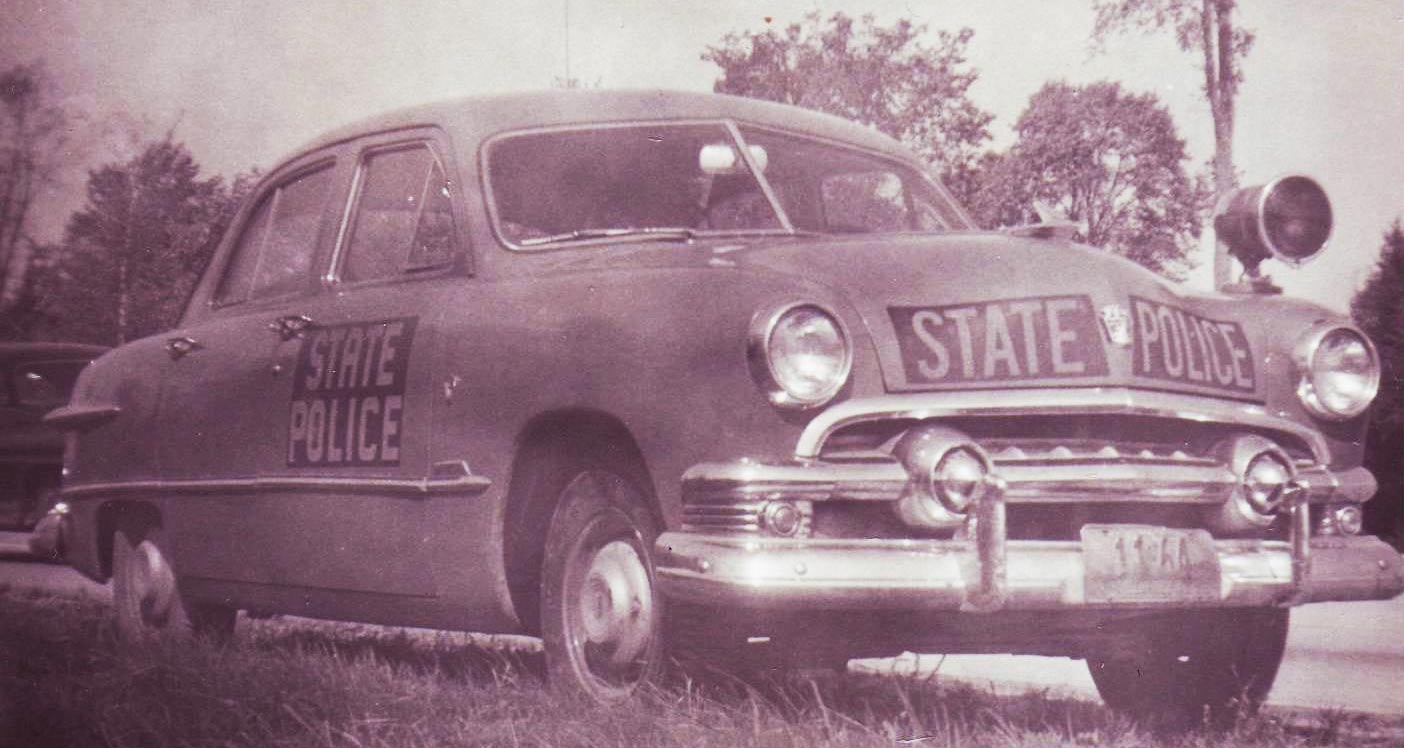
1951-1952 issue. Deep yellow over black. NY-THE EMPIRE STATE-51 along bottom of plate.
(Courtesy Kevin Enser)
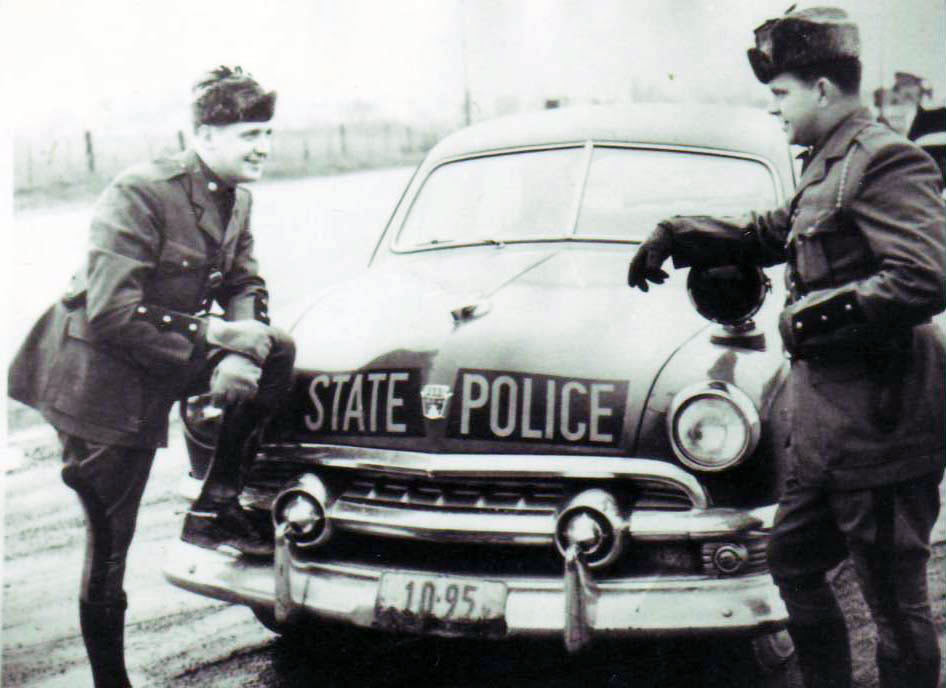
1951-1952 issue. Deep yellow over black. NY-THE EMPIRE STATE-51 along bottom of plate.
Showing M.D. Gavin and Joe Strunk out of A Troop in Batavia NY- 1952
(Courtesy Kevin Enser)

1951
(Courtesy Allan Attanasio)

1952 in 20-## and 12-## series.
(Courtesy Mark Scarselli)
In 1953, the exact same format and layout was used but with the colors reversed to deep yellow over black and NY-THE EMPIRE STATE-53 along the bottom.
It was around this time when other reserved numbers were seen used, including some in the 20-## and 30-## series. There is no information to date as to what those other number blocs were and if there were any other used.
These license plates were validated for 1954 with a validation tab. The embossed metal tab measuring 2" x 2 1/2" had 54 painted in black over a deep yellow background.

Troop K- 1953
(Courtesy Mark Scarselli)


1955 NYSP Ford--Calibrating speedometer
(Courtesy Kevin Enser)

1955 NYSP Ford
(Courtesy Kevin Enser)

1955 NYSP Ford showing use of a standard passenger car license plate number.
(Courtesy Kevin Enser)
In 1955, New York issued new full-sized license plates again. They were identical to the 1951 plates but this time the state, slogan and year spanned the top of the plate instead of the bottom.
The plates were still made of embossed steel and measuring 6 1/4" x 13 1/2". The color scheme was black over deep yellow. Along the entire upper span of the plate just below the mounting holes was NY-THE EMPIRE STATE-55.
NYSP numbers were still allotted the reserved number series 9-##, 10-##, 11-## and 12-##, however lead pair of numbers on some plates were also seen in the 20, 30, 40 and 50 number blocs.
These plates were validated for 1956 with a validation tab. The embossed metal tab measuring 2" x 2 1/2" had 52 painted in deep yellow over a black background.
The photo seen below taken in the Spring of 1956 shows an NYSP patrol car with number 54-54 on the 1956 license plate.


1956. NYSP patrol car with plate # 54-54.
1957 was a watershed year for how NYSP registered their patrol cars. Gone were the special reserved-number passenger license plates and in came a special agency-specific type.
In 1956, all of North America entered into an agreed standard sizing of automobile license plates as 6" x 12". That year, New York was in the midst of using a validation tab for the previous full-sized 1955 license plate. Therefore it was not until 1957 that all license plates for motor vehicles other than motorcycles went to the newer, smaller sized plates.
Much like the license plates prior, they were identical to the plates used by regular passenger vehicles except the plates were issued with a DSP (Division of State Police) prefix, a dash followed by a number up to 3 digits. The bottom part of the plate had NY in the bottom left corner, EMPIRE STATE in the bottom center of the plate and 57 in the bottom right corner of the plate.
The New York State Police in cooperation with the state's Commissioner of Motor Vehicles, embarked on an experiment in license plate material testing that year. The plates were made of embossed steel, but what made these NYSP license plates particularly special besides their DSP prefix was that the deep yellow paint used for the embossed portions of the plate was made with retro-reflective properties using finely-crushed glass beads. This experiment using this new material was developed with officer/public safety in mind. This new coating was supposed to offer increased visibility in dark conditions when a light source made contact with the reflective material in the coating.
The plates were used until December of that year where they were ordered removed and returned to the Commissioner of Motor Vehicles in Albany for examination and disposal. There are only TWO of these first-issue DSP license plates known in existence today.
The experiment proved unsuccessful as reflective material was not used on NYSP license plates again until 1973.
It has also been stated that Troop A ended-up getting the lowest blocs of numbers followed by Troop B, C etc...It is believed that plates in the 800 series went to the newly-formed Troop T which patrolled the recently-completed New York State Thruway.
This is the 1957 letter from NYSP Commissioner (Courtesy Eric Tanner)

 1957 issue. Division of State Police
1957 issue. Division of State Police 1957
1957




 1957. New York State Thruway.... "Really sir?... a U Turn right at the sign that says "NO U TURNS" !?! "
1957. New York State Thruway.... "Really sir?... a U Turn right at the sign that says "NO U TURNS" !?! " NYSP 40th Anniversary- 1957
NYSP 40th Anniversary- 1957 1958 issue. Division of State Police
1958 issue. Division of State Police
 1958- Troopers Charlie Bundschuh and Dusty Rhodes
1958- Troopers Charlie Bundschuh and Dusty Rhodes 
License plate assigned to and used by NYSP's fifth Superintendent, Francis Simpson McGarvey.
On Jan. 24, 1955, Gov. W. Averill Harriman appointed Chief Inspector Francis S. McGarvey, head of the BCI, to replace Supt. Johnson. Born Dec. 15, 1896 in New York City, Supt. McGarvey was a true American success story in the Horatio Alger mold. A self-made man whose formal education ended with one year of high school, Supt. McGarvey was one of the original NYSP Camp Newayo "camp men". He enlisted with the state police July 12, 1917, after serving a three-year hitch with the U.S. Army, which included active duty on the Mexican Border in 1916.
During his long career, he held, in succession, every rank it was possible for a New York State Trooper to achieve: trooper (1917), corporal (1918), sergeant (1919), 1st sergeant (1921), lieutenant (1923), BCI district inspector (1935), BCI division inspector (1936), captain-troop commander (1939) and chief inspector-BCI (1944).
Supt. McGarvey's experience and expertise was acquired in a lifetime devoted to professional law enforcement, and his knowledge of the New York State Police was comprehensive. Police officer training and continuing education were high among his priorities, as was a desire to ensure field personnel were equipped with the latest tools: high-performance troop cars, modern inter-state teletype connections, the replacement of blood-testing equipment with the Breathalyzers for DWI enforcement, and the introduction of SCUBA equipment for state police divers.
By the late 1950s, however, the state police still operated under a quasi-military system that required troopers to live in barracks and work 120-hour weeks. Supt. McGarvey was slow to appreciate that such demands, while contemporary for troopers of the 1920s and 30s, were increasingly out-of-date in the post-war era. He refused for two years to act on new rules governing time and attendance for troopers, and it required a direct appeal from the Civil Service Employees Association (CSEA) to the governor in 1958 before the Division of State Police adopted a revamped 12-hour day and five-day work week.
Gov. Nelson A. Rockefeller retained Supt. McGarvey after he took office in January 1959. He followed his predecessors into retirement on Feb. 8, 1961 and died July 3, 1969, having dedicated 44 of his 73 years to the service of the New York State Police and the people of New York State.
(Courtesy Jim Aitken)

 1958. DSP-7...low number would indicate a Troop A plate.
1958. DSP-7...low number would indicate a Troop A plate. 1959 validation tab for 1958 license plate.
1959 validation tab for 1958 license plate. 

In 1960, New York went back to the same color and format as the 1957 plate with a deep yellow over black version of the EMPIRE STATE license plate. For NYSP plates, regular deep yellow paint was used for the raised characters on the plate instead of the reflective type.
These plates were validated for 1961 by use of an embossed metal tab measuring 2" x 2 1/2". 61 painted black over a deep yellow background. Engraved serial number along right margin.
 NY State Thruway- 1960
NY State Thruway- 1960 
 1961. Speedometer calibration.
1961. Speedometer calibration. 1962 issue. Division of State Police
1962 issue. Division of State Police
 1962
1962  Busted on the New York State Thruway-1962.
Busted on the New York State Thruway-1962.  Tpr. Anthony J. Scarselli- Winter 1962
Tpr. Anthony J. Scarselli- Winter 1962 1962
1962 1962 issue with 1963 validation tab.
1962 issue with 1963 validation tab. 
 NY State Thruway-1962
NY State Thruway-1962 1963-Dark protrusions on the trunk lid are bilge vents. These were installed to ventilate the trunk where 2 gallons of spare gasoline was carried in order to assist stranded motorists on the Thruway.
1963-Dark protrusions on the trunk lid are bilge vents. These were installed to ventilate the trunk where 2 gallons of spare gasoline was carried in order to assist stranded motorists on the Thruway.  1963. Trooper Kenneth Earle
1963. Trooper Kenneth Earle (Courtesy Robert Francisco)
(Courtesy Robert Francisco)Twenty four years after hosting their last World's Fair, New York was preparing once again to host the planet for the 1964 World's Fair. This time was no different as it related to promoting the event on the state's license plates.
The 1964 NYSP license plates were deep yellow over black with the DSP prefix, a dash and a number up to three digits.
NY was situated in the lower left corner, WORLD'S FAIR at the bottom center and 64 at the bottom right corner.
These plates were validated in 1965 by a black over reflective red validation decal.
 1964 issue. Division of State Police
1964 issue. Division of State Police
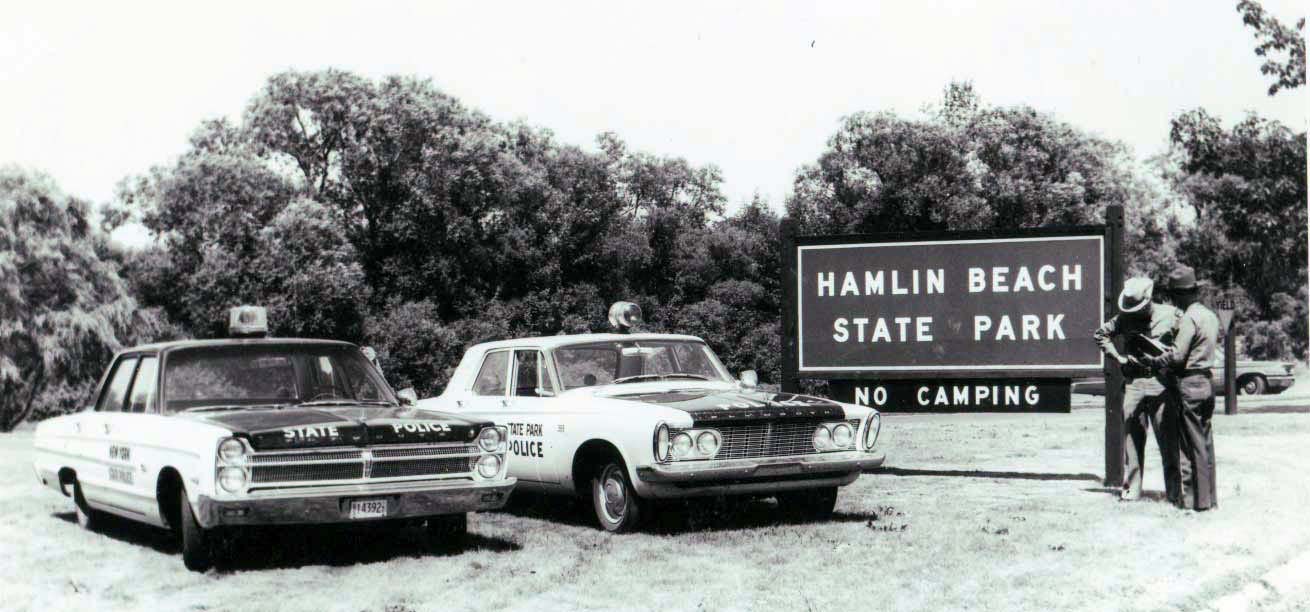 1965. Hamlin Beach State Park just outside Rochester on Lake Ontario.
1965. Hamlin Beach State Park just outside Rochester on Lake Ontario.  1965 issue NY State Thruway Toll plate.
1965 issue NY State Thruway Toll plate.
 1965 issue. Division of State Police
1965 issue. Division of State Police
 Excerpt from NY Troopers Magazine 1965
Excerpt from NY Troopers Magazine 1965 Radar Duty 1966.
Radar Duty 1966.In 1966, New York state went through a revolutionary change in license plate issuance. For over 30 years the state's license plates alternated between black and deep yellow color schemes and the abbreviation NY on the majority of the annual issues. Now, the state name was to be spelled out in full on a plate with a deep blue background and bright orange characters.
The plates were designed to last several years and the bottom right corner of the plate had a validation decal "navel" to accommodate a host of annual validation stickers as the years would go by.
NYSP license plates continued with the DSP prefix followed by a dash and a number up to three digits.
These license plates were issued until DSP 999 was reached. It was after that point that a new design was launched in late 1968, however the DSP-### plates continued to be used and re-used concurrent to the new issue until 1973.
 Low numbered DSP issue (Troop A) 1966
Low numbered DSP issue (Troop A) 1966 1966 issue. Division of State Police
1966 issue. Division of State Police
 1966
1966
 1967 issue. Division of State Police
1967 issue. Division of State Police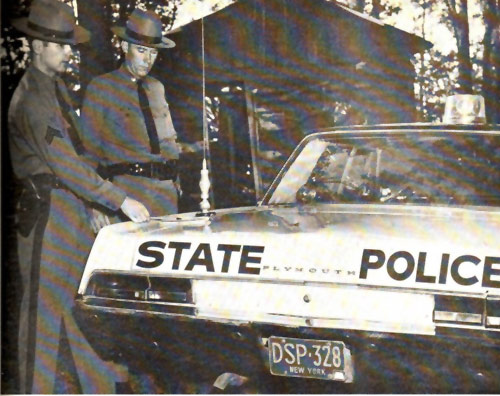
 (Courtesy Jim Schaller)
(Courtesy Jim Schaller) Ready for blast-off! New York State Thruway- 1967
Ready for blast-off! New York State Thruway- 1967  DSP license plates in the 800 bloc of numbers were issued to Troop T (NY State Thruway)
DSP license plates in the 800 bloc of numbers were issued to Troop T (NY State Thruway) 1968 issue. Division of State Police
1968 issue. Division of State Police
When the DSP series license plates reached DSP 999, most of those plates would eventually get re-issued as older cars were exchanged for new ones, therefore some of the 1966 issue plates did get utilized by more than one patrol car within its service life.
To ensure a less-restrictive way of identifying their
vehicles, the NYSP unveiled a new "Troop plate" introduced in December
of 1968. The plate was the same color and material as the 1966 DSP
plates, but along the bottom of the plate it read: NY STATE POLICE
NY.
A 4 to 5 digit number was used with each 1000 bloc dedicated to
a particular Troop as seen below:
1000 bloc: TROOP A covering the counties of Allegany, Cattaraugus,
Chautauqua, Erie, Genesee, Niagara, Orleans, Wyoming
2000 bloc: TROOP B covering the counties of Clinton, Essex, Franklin,
Hamilton, St. Lawrence
3000 bloc: TROOP C covering the counties of Broome, Chenango, Cortland,
Delaware, Otsego, Tioga and Tompkins
4000 bloc: TROOP D covering the counties of Herkimer, Jefferson, Lewis,
Madison, Oneida, Onondaga, Oswego
5000 bloc: TROOP E covering the counties of Cayuga, Chemung, Livingston,
Monroe, Ontario, Schuyler, Seneca, Steuben, Wayne, Yates
6000 bloc: TROOP F covering the counties of Greene, Orange, Rockland,
Sullivan, Ulster
7000 bloc: TROOP T covering the New York State Thruway
8000 bloc: TROOP G covering the counties of Albany, Fulton, Hamilton,
Montgomery, Rensselaer, Saratoga, Schenectady, Schoharie, Warren,
Washington
9000 bloc: Troop K covering the counties of Columbia, Dutchess, Putnam, Westchester
10-000 bloc: Troop L covering the counties of Nassau and Suffolk.
The troop plates ending in zero-zero-zero were reserved for the Troop Commander and numbers ascended by rank/seniority within the Troop.
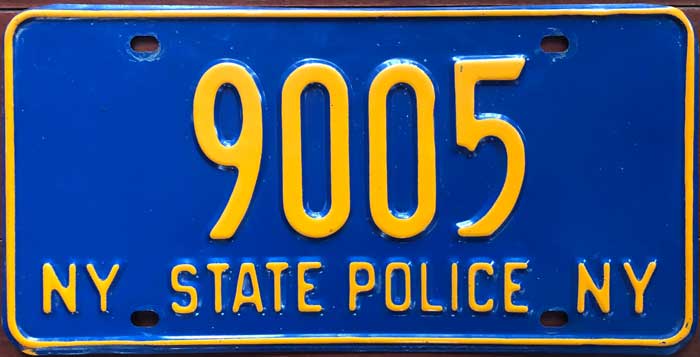 1968-1972 issue. Embossed steel.
1968-1972 issue. Embossed steel.
 Woodstock Festival 1969- NYSP Troop F (#6238)
Woodstock Festival 1969- NYSP Troop F (#6238) From 1968 scrapbook of Automobile License Plate Collector's Assn. Member #734 Joe Kohlhas of Buffalo indicating the new NYSP plates introduced to replace the old DSP prefix plates.
From 1968 scrapbook of Automobile License Plate Collector's Assn. Member #734 Joe Kohlhas of Buffalo indicating the new NYSP plates introduced to replace the old DSP prefix plates. 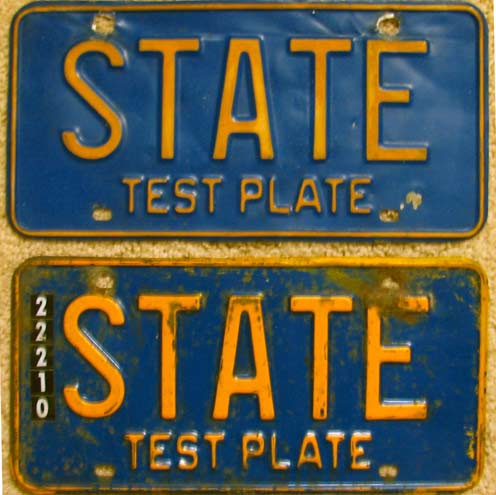 1967-1971 State Test Plates. Used to test different coatings and raw material over given period time and under frequent outings in all kinds of weather, road conditions and speeds.
1967-1971 State Test Plates. Used to test different coatings and raw material over given period time and under frequent outings in all kinds of weather, road conditions and speeds.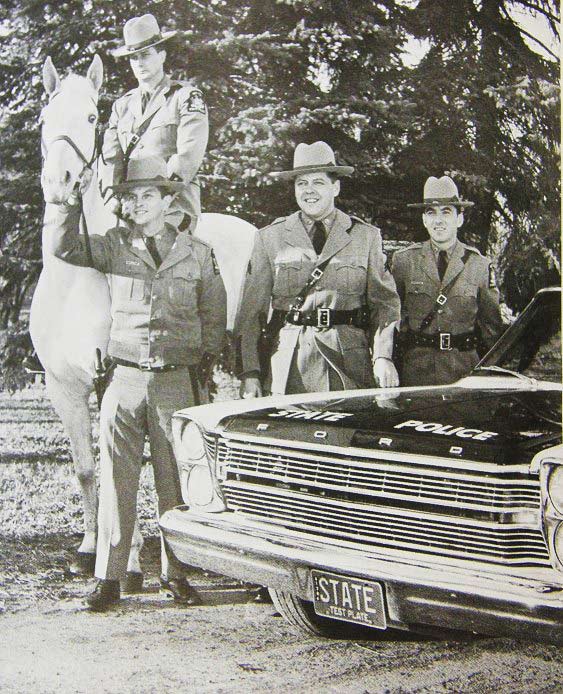 1967- State Test Plate mounted on NYSP Ford Galaxie.
1967- State Test Plate mounted on NYSP Ford Galaxie.As the NYSP was using the contemporary 1966 DSP prefixed and 1968 Troop plates on their patrol vehicles during this time, some NYSP patrol cars were selected to run special project test plates issued by the Commissioner of Motor Vehicles. These test plates were run on the front of selected NYSP and other state vehicles from as early as January of 1967 and as late as June of 1971. The plates were of the same color and layout as the 1966 base plates in use by the state at the time. The registration number was replaced with the word STATE and the state name was replaced with the word TEST PLATE. It is believed that although no reflective material was used on the plates (as with the 1957 experiment), that the paint itself was being tested to determine durability under the most trying conditions.
 1969 issue. Division of State Police
1969 issue. Division of State Police
 (Courtesy Tom Sheehy)
(Courtesy Tom Sheehy) 1968-1972 issue. Troop C # 3030
1968-1972 issue. Troop C # 3030 Troop E #5095 with NY Thruway Plate # 8142 on grille and # 5043- November 1970
Troop E #5095 with NY Thruway Plate # 8142 on grille and # 5043- November 1970 1970 issue. Division of State Police
1970 issue. Division of State Police
 1971 issue. Division of State Police
1971 issue. Division of State Police
In 1973, New York once again re-plated. Harsh winters with lots of road salt took their toll on the blue plates issued to New York motorists seven years earlier. This time the state went to a dark blue over reflective orange/gold base on galvanized steel.
NYSP license plates continued in the same pattern for their well-liked troop plates as the format remained the same with only the reverse coloring being the only change.
Depending when some of the plates were made between 1973 and 1984, the background color varies from more orange in shade to more gold.
 1973-1984 issue.
1973-1984 issue.  1973-1984 issue.
1973-1984 issue.  1977- Troop A
1977- Troop A
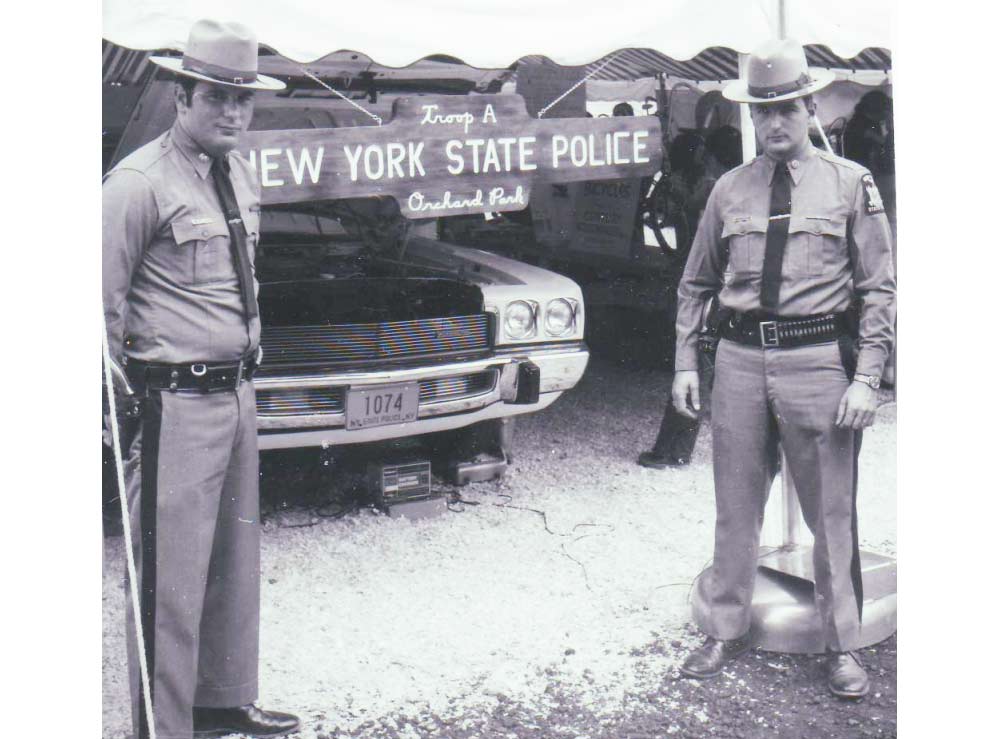 Troopers Bill Hubert and Bob Dossinger out of Troop A
Troopers Bill Hubert and Bob Dossinger out of Troop A Troop K
Troop K Troop G (8300)
Troop G (8300) 1977- John Schmidt and John F. Ryan at Troop K Open House
1977- John Schmidt and John F. Ryan at Troop K Open House Troop D- Circa 1975
Troop D- Circa 1975 Troop D- Blizzard of 1977
Troop D- Blizzard of 1977  1973-1984 issue.
1973-1984 issue.  1973-1984 issue.
1973-1984 issue.  Troop L #129
Troop L #129 1974- Troop G
1974- Troop G 1982- Troop A
1982- Troop A 1983- Troop D (Oneida)
1983- Troop D (Oneida)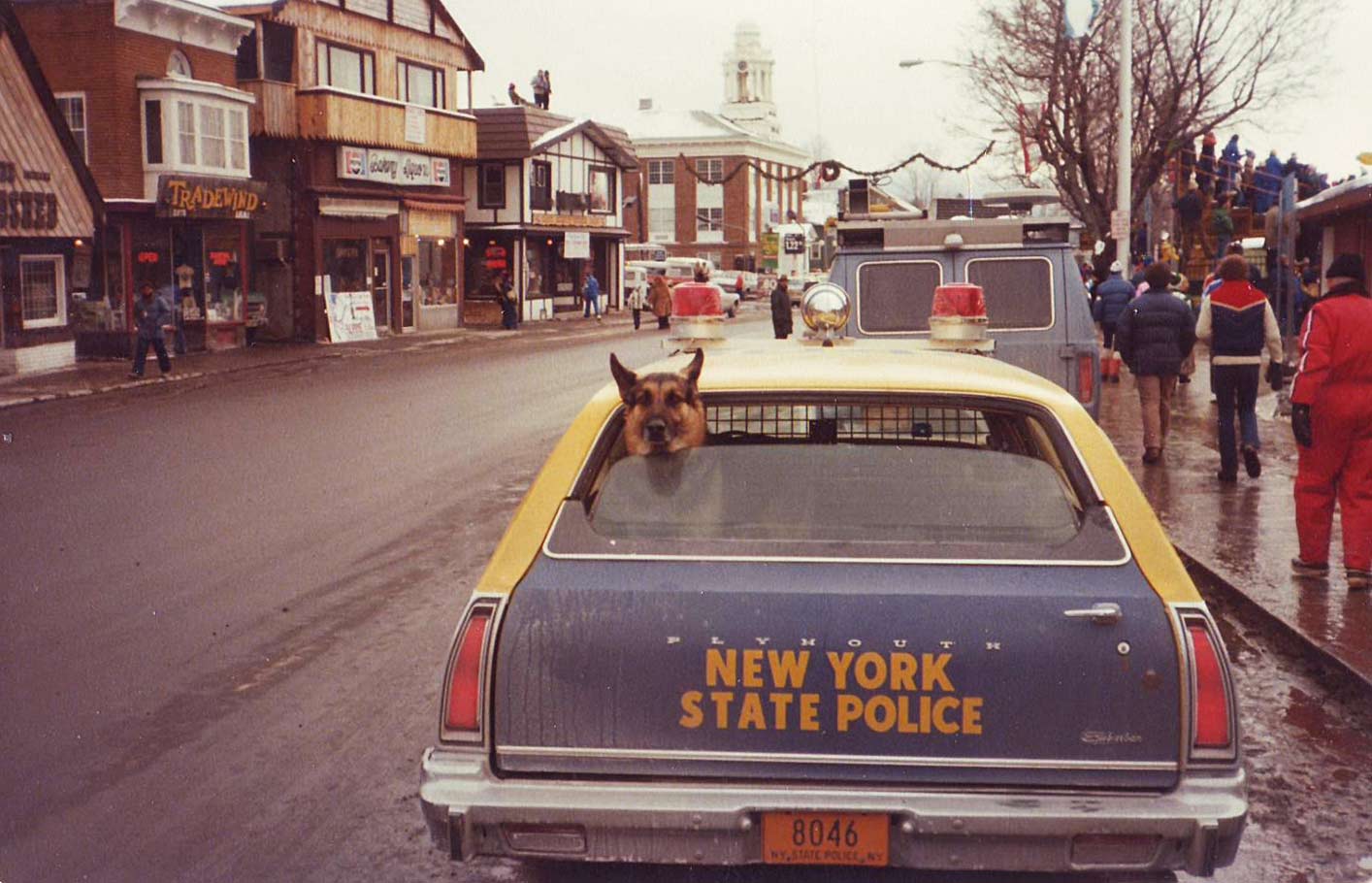 1977- Troop G - Canine.
1977- Troop G - Canine.In September of 1984, the same color scheme of dark blue over reflective orange/gold continued, however the formatting for NYSP license plates changed.
NEW YORK was spelled out in full at the bottom center of the plate and the embossed validation decal "navel" in the bottom right corner returned as it had looked when the 1966 base was launched.
The prefix DSP (Division of State Police) also returned, however this time it appeared as an oblique descending right from the top left corner of the plate. Troop cars had a zone number (1 thru 4) which preceded the Troop letter followed by a number up to two digits indicating the car and radio number.
Troop Command Staff and special units within the troop used similar plates but with no zone number.
A zone number of 5 would indicate an inspector assigned to the Troop.
The Troop assignments as of September of 1984 were as follows:
Troop A Headquartered in Batavia
Troop B Headquartered in Malone
Troop C Headquartered in Sidney
Troop D Headquartered in Oneida
Troop E Headquartered in Canadaigua
Troop F Headquartered in Middletown
Troop G Headquartered in Loudonville
Troop H Headquartered at General HQ- Albany
Troop K Headquartered in Poughkeepsie
Troop L Headquartered in Long Island
Troop M Headquartered in Manhattan (Detective office- later renamed
Troop NYC)
Troop T Headquartered in Albany for the New York State Thruway
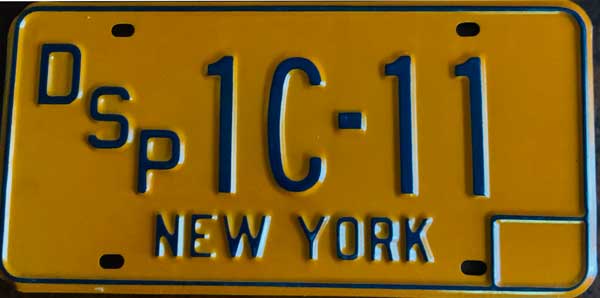 1984-1986 issue.
1984-1986 issue. 

 Troop G- Zone 2
Troop G- Zone 2 1984-1986 issue.
1984-1986 issue. 
 1984-1986 issue.
1984-1986 issue. 
 1984-1986 issue SAMPLE.
1984-1986 issue SAMPLE.
 NYSP Plymouth Gran Fury with NY State Thruway markings.
NYSP Plymouth Gran Fury with NY State Thruway markings. Possible transitional type as older dark blue-over-reflective orange color scheme and layout including NY STATE POLICE NY in silkscreen used on newer 1986 aluminum blank with newer/thinner embossed dies.
Possible transitional type as older dark blue-over-reflective orange color scheme and layout including NY STATE POLICE NY in silkscreen used on newer 1986 aluminum blank with newer/thinner embossed dies.  Possible transitional type as older dark blue-over-reflective orange color scheme used on newer 1986 aluminum blank with newer/thinner embossed dies including stacked DSP prefix.
Possible transitional type as older dark blue-over-reflective orange color scheme used on newer 1986 aluminum blank with newer/thinner embossed dies including stacked DSP prefix.In 1986, New York went to a radical new approach with how their license plates looked. The state went to a graphic design which other states had already embarked upon for their own styles years prior.
The initial batch of new graphic plates were made of galvanized steel, but then by 1992, the state switched to aluminum.
The plates had a reflective white background and featured the image of the Statue of Liberty silkscreened in red at the far left of the plate. There was a screened red line running horizontally above the upper mounting holes over NEW YORK in dark blue silkscreened script. A screened line in red ran horizontally below the lower mounting holes. Subdued in the background, visible only on reflected light, is a repetitive hologram with the state map inside a circle and "LIBERTY" inside the map which runs vertically through the center across the statue from top to bottom.
The DSP (Division of State Police) prefix is embossed in dark blue and stacked vertically in the prefix position to the left of the assignment number. Zone vehicles have the Zone Number followed by the Troop letter, a dash and the car/radio number all embossed in blue.
Some NYSP license plates issued in September of 1988 were missing the dash which separted the Troop letter from the assignment number.
By June of 1989, the dash re-appeared.
 1986-1995 issue. Embossed aluminum.
1986-1995 issue. Embossed aluminum.
 SSP Mustang with Troop D (Oneida) Zone 2 plate with no dash separator.
SSP Mustang with Troop D (Oneida) Zone 2 plate with no dash separator.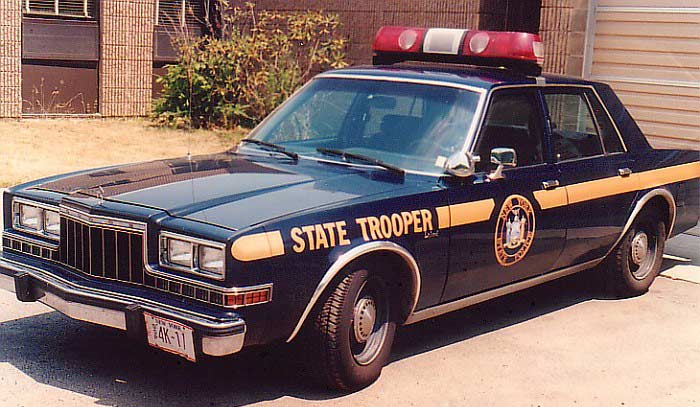 Troop K (Poughkeepsie) Zone 4
Troop K (Poughkeepsie) Zone 4 Troop L (Long Island) Zone 2
Troop L (Long Island) Zone 2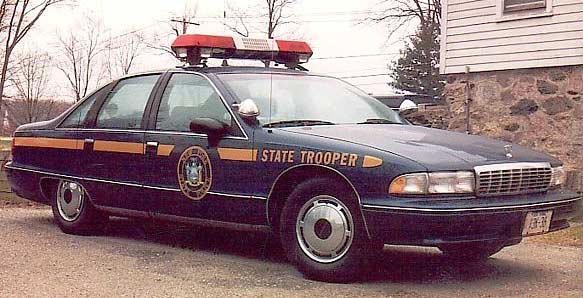
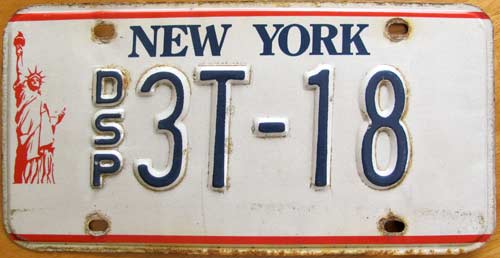 1986-1995 issue.
1986-1995 issue. 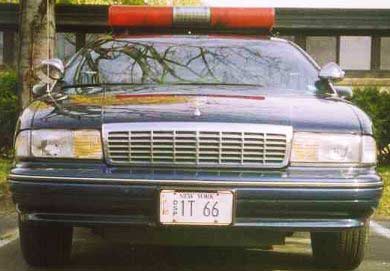 Thruway Zone 1 (Tarrytown, New Rochelle, Newburgh)
Thruway Zone 1 (Tarrytown, New Rochelle, Newburgh)

 1986-1995 issue. Embossed aluminum.
1986-1995 issue. Embossed aluminum.
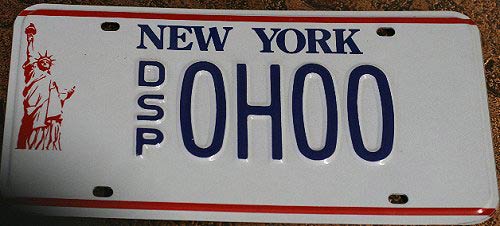 1986-1995 issue. SAMPLE
1986-1995 issue. SAMPLE 1986-1995 issue. SAMPLE with narrower dies.
1986-1995 issue. SAMPLE with narrower dies.By late 1994/early1995, the NYSP began using very distinctive all-graphic license plates. The plates were made with technology provided by a German company based out of New Jersey called Azon-Utsch. This company spearheaded the advancement of "thermo-transfer print" digital technology for license plate manufacturing in the USA: a digital means of applying license numbers to license plates without the need for the traditional stamping press. A sheet of reflective material comprised of the layout, format and license number was adhered tothe aluminum base plate.
It was the beginning of "cut and paste" license plate manufacturing in North America. These plates were not just relegated to the exclusive use of the NYSP, but also for special-issue graphic and personalized license plates issued in New York State. These plates are all-screened and have no embossed characters. Only the contour of the plate is step-bordered. The design of this plate utilized a retro-reflective white base plate with a dark blue banner placed across the top of the plate with NEW YORK in a stylized font in white, similar to that used by the New York Yankees baseball organization. Below that is a sliver of white showing horizontally across the plate followed by a thin red horizontal stripe that spans the length of the plate. Below that to the far left is a circular emblem depicting the New York coat-of arms and the words NEW YORK along the top of the circle and STATE POLICE along the bottom of the circle. To the immediate right of the emblem is the assignment number in dark blue "Zurich Extra Condensed" font. Between the lower mounting holes in dark blue is the line reading: STATE POLICE- Proudly Serving Since 1917. Below the lower mounting holes is the reverse order of the red, white and blue horizontal stripes. The earliest rendition of these plates utilized the "slashed zero" to differentiate the character from the letter "O". After several months of "legibility problems" on the road, a directive was sent from General Headquarters that all NYSP license plates with the "slashed zero" were to be returned to Albany for exchange with a "clean zero" substitute. All "slashed zero" license plates were to have subsequently been destroyed, but a few have been found to have escaped such a dire fate.
The numbering sequence for the current issue NYSP license plates (and perhaps the previous issues as well, although not confirmed) follow this typical assignment.
The letter L refers to the Troop Letter:
L1 - Major
L2-L4 - Captains
L5 - Bureau of Criminal Investigation Captain
L10-L49 - Troop Administration - Marked cars
L50-L69 - Troop Administration - Unmarked cars
L70-L89 - CVEU, box trucks, SCUBA, Canine, etc.
L90-L99 - Troop Communications
L101-L109 - Traffic Incident Management Team
1L1 - Lieutenant
1L10-1L49 - Marked Cars (County cars/non-interstate)
1L50-1L59 - Unmarked Cars
1L60-1L79- Interstate Patrol cars
1L80-1L99 - Miscellaneous Units
Bureau of Criminal Investigation
L5 - BCI Captain
5L1 - BCI Lieutenant
5L5-5L24 - BCI Senior Investigators
5L25-5L199 - BCI Investigators
7L###- Non NYSP units (Ie: 7G201 is Clifton Park NY Security)
8L###- NY State Park Police
9L##- Dispatchers
 1995-2016 issue.
1995-2016 issue. 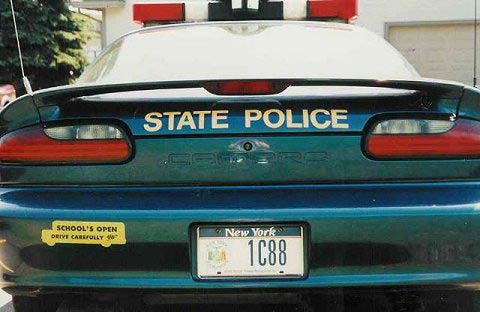
 Troop F- Zone 3-
Troop F- Zone 3- 

 1995-2016 issue.
1995-2016 issue. 

 1995-2016 issue.
1995-2016 issue.  Troop C- Zone 3 (covers stations of Ithaca, Berkshire, Newfield, Homer, Marathon and Owego)
Troop C- Zone 3 (covers stations of Ithaca, Berkshire, Newfield, Homer, Marathon and Owego)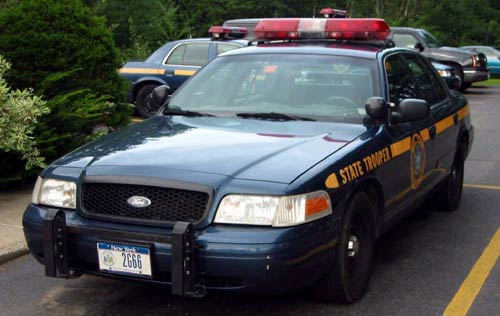 Troop G-Zone 2 (Covers stations of Wilton, Bolton Landing, Charlton, Chestertown, Clifton Park, Granville, Greenwich, Hadley, Queensbury, Saratoga, Schuylerville and Northway)
Troop G-Zone 2 (Covers stations of Wilton, Bolton Landing, Charlton, Chestertown, Clifton Park, Granville, Greenwich, Hadley, Queensbury, Saratoga, Schuylerville and Northway) Troop T-5 as a zone number indicates inspector/BCI
Troop T-5 as a zone number indicates inspector/BCI
 1995-2016 issue.
1995-2016 issue.  Troop C (Sidney) Headquarters
Troop C (Sidney) Headquarters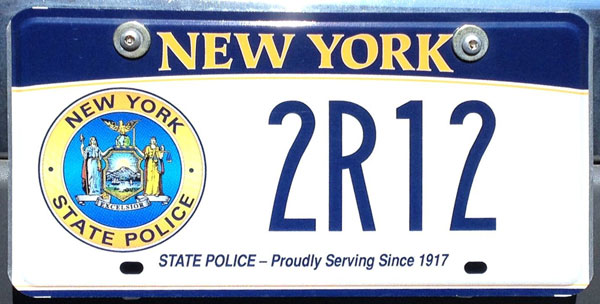 2010-Current style for NYSP Academy.
2010-Current style for NYSP Academy. NYSP Academy plate number 3R24.
NYSP Academy plate number 3R24. Academy Training 2023
Academy Training 2023

 1995-2016 issue.
1995-2016 issue. 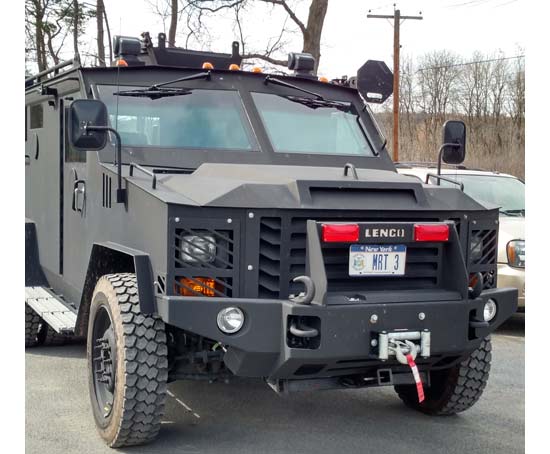
 1995-2000.
1995-2000. 
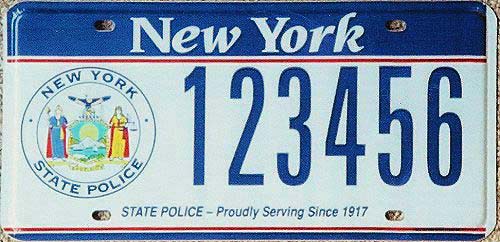 1995-2016 SAMPLE (early version)
1995-2016 SAMPLE (early version) 1995-2016 SAMPLE (later version)
1995-2016 SAMPLE (later version)In the latter half of 2016, the New York State Police began to prepare for its approaching milestone of 100 years in the service to the state of New York. Centennial celebration ideas for 2017 were launched and one aspect of the occasion was to launch a new license plate to replace the one that had been around for over the past 20 years. The new plates were once again made of entirely silkscreened aluminum with a step border. The top of the plate has the state name silkscreened in yellow-orange against a dark blue band that curves slightly downward at each end. A thin yellow pin stripe mirrors the bottom edge of the band curve from end to end. The state seal once again appears in the center left field of the plate, however with a more filled-in color of a gold circumference surrounding a full color state seal against a royal blue backdrop.
The numerals are silkscreened in dark blue from the mid-center to the right field of the plate.
The slogan "STATE POLICE- Proudly Serving Snce 1917" is silkscreened in red at the bottom center of the plate.


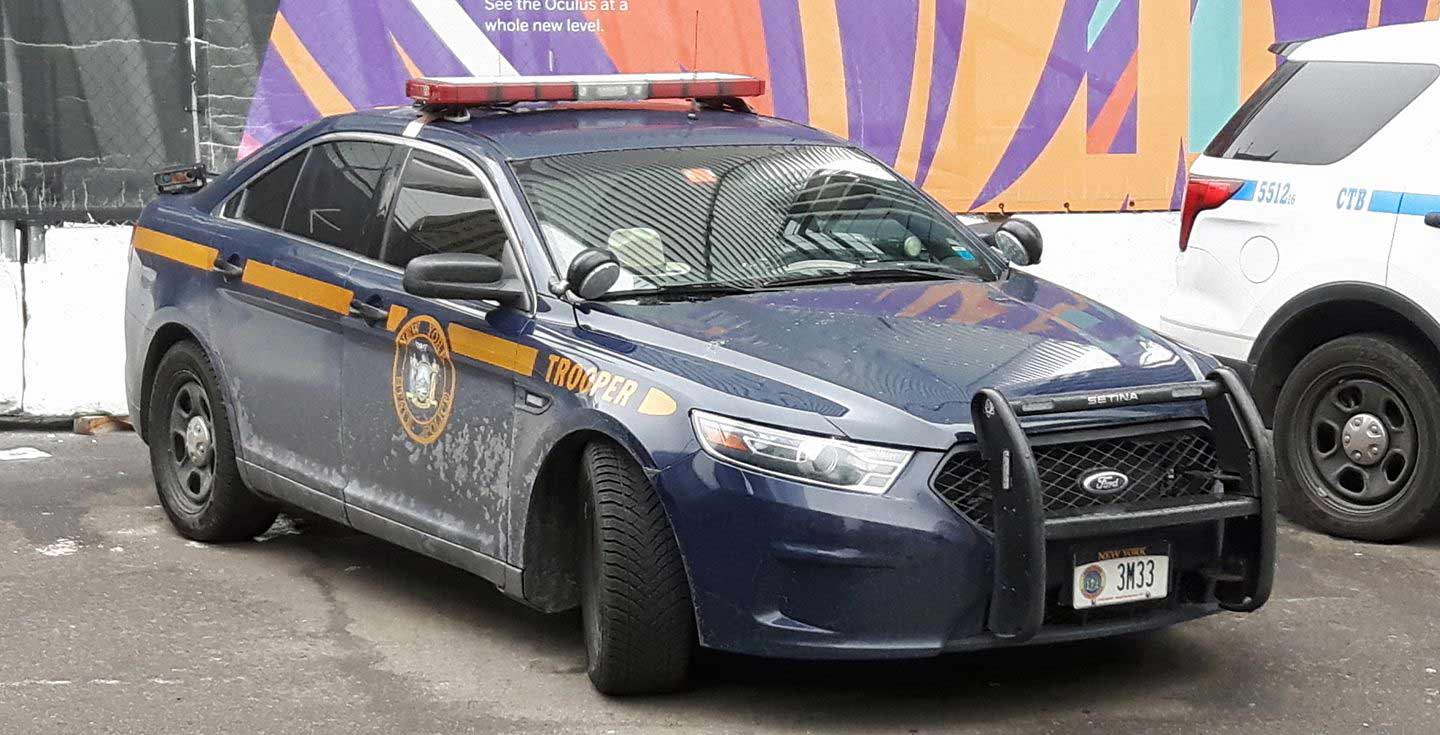 Winter 2017 seen in Manhattan
Winter 2017 seen in Manhattan Troop M (Manhattan) Zone 1
Troop M (Manhattan) Zone 1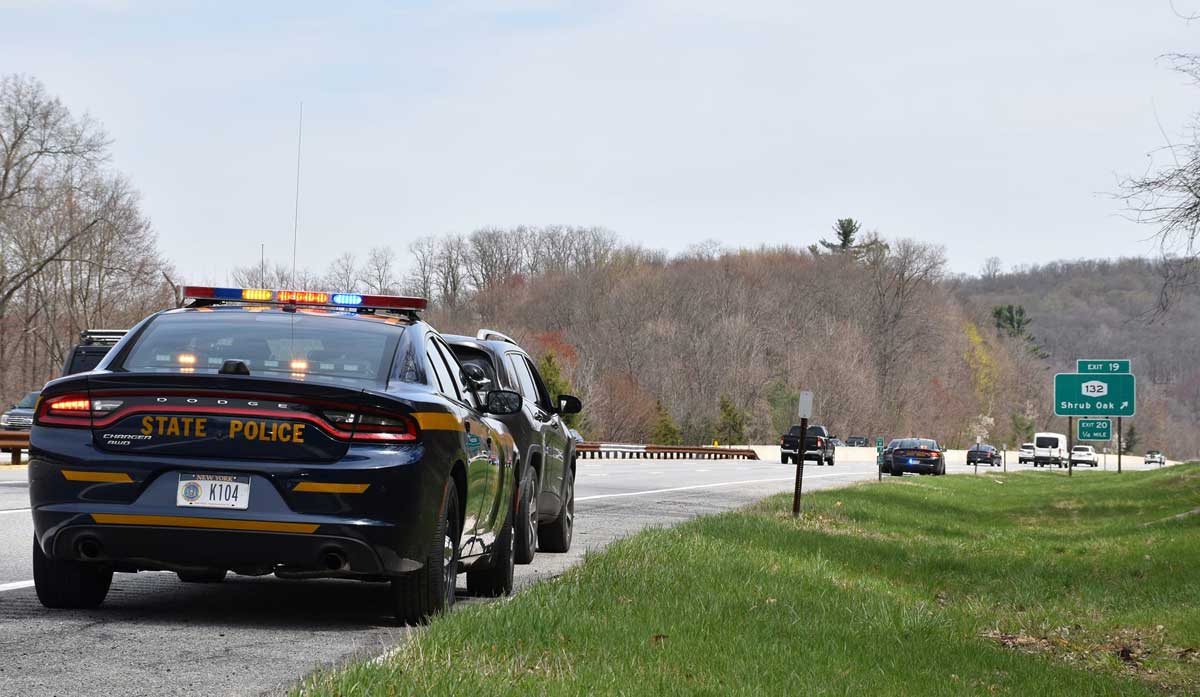 2021- Troop K Traffic Incident Management Team
2021- Troop K Traffic Incident Management Team 2022- Troop C Traffic Incident Management Team
2022- Troop C Traffic Incident Management Team Troop G- Zone 1
Troop G- Zone 1 2023- Troop C- Zone 3
2023- Troop C- Zone 3The earliest information on motorcycle use by the NYSP goes back to 1918. Three motorcycles for each of the NYSP's four troops were acquired for patrol. All of them were colored granite grey and had sidecars. Each motorcycle had two riders: a senior man and a relief rider. The latter of which was used only when the senior man was off duty or on assignment elsewhere.
The riding season was from May until October and only in daylight hours and good weather.
In these earliest of days of motorcycle use by the NYSP, only standard high-numbered civilian motorcycle license plates were used. A confirmed NYSP motorcycle license number of 21824 for 1921 is an indicator. The plates were made of embossed steel and mirrored the color combination use of the passenger car plates of each year. The plates measured 3 1/2" x 6 3/4" and had embossed borders. The number up to five digits was embossed over N.Y. followed by the year in full up until 1927 when only the last two numbers of the year were used.
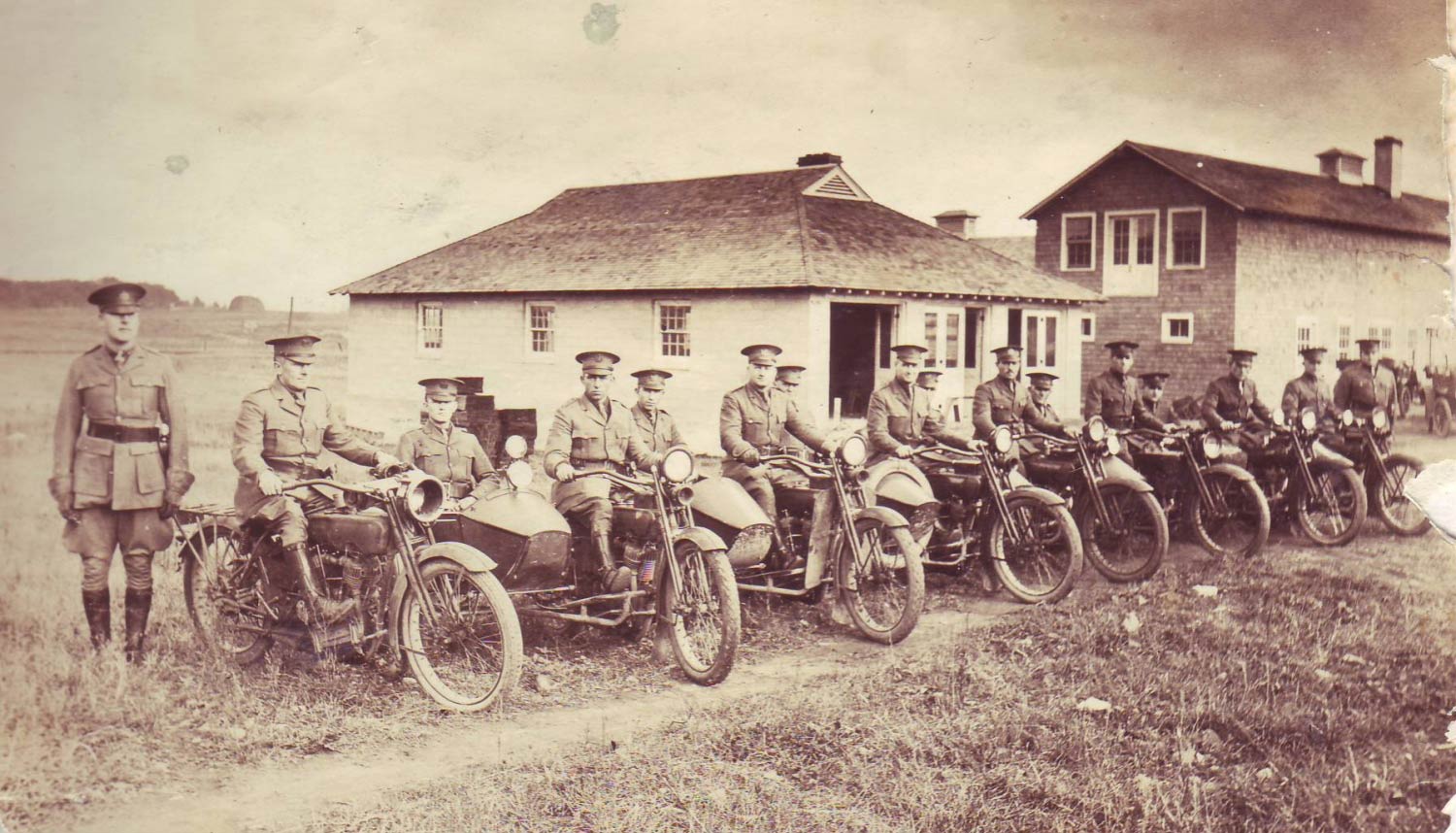
By 1927, the NYSP began using low-numbered civilian issue motorcycle license plates on their rides. It was in that year that the dimensions for the motorcycle license plates changed to 3 1/2" x 7 1/4". The following year, the dimensions returned to 3 1/2" x 6 3/4" for plate numbers under 4 digits.


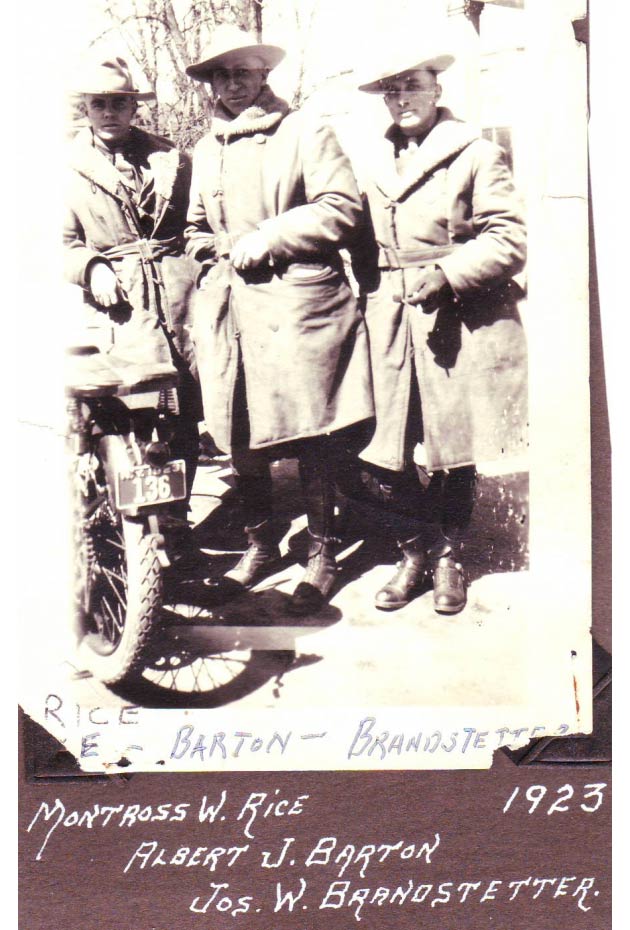


Aside from the use of numbered motorcycle license plates used on the rear of the NYSP motorcycles at that time, there was also the use of fender signs on the front fenders of most NYSP cycles from the 1920's through the 1960's.
Some of these fender signs would be generic with only the word POLICE on both sides, some with great detail identifying NY STATE POLICE and even the troop headquarters designation. The plates were typically black with the inscription painted in gold with red outline.


Photo shows a well-detailed front fender sign indicating the NYSP rider's assignment out of Troop A in Batavia. Notice in the photo below that no front fender sign was used on that particular motorcycle.
Also note plate number 933 on the NYSP car behind him.




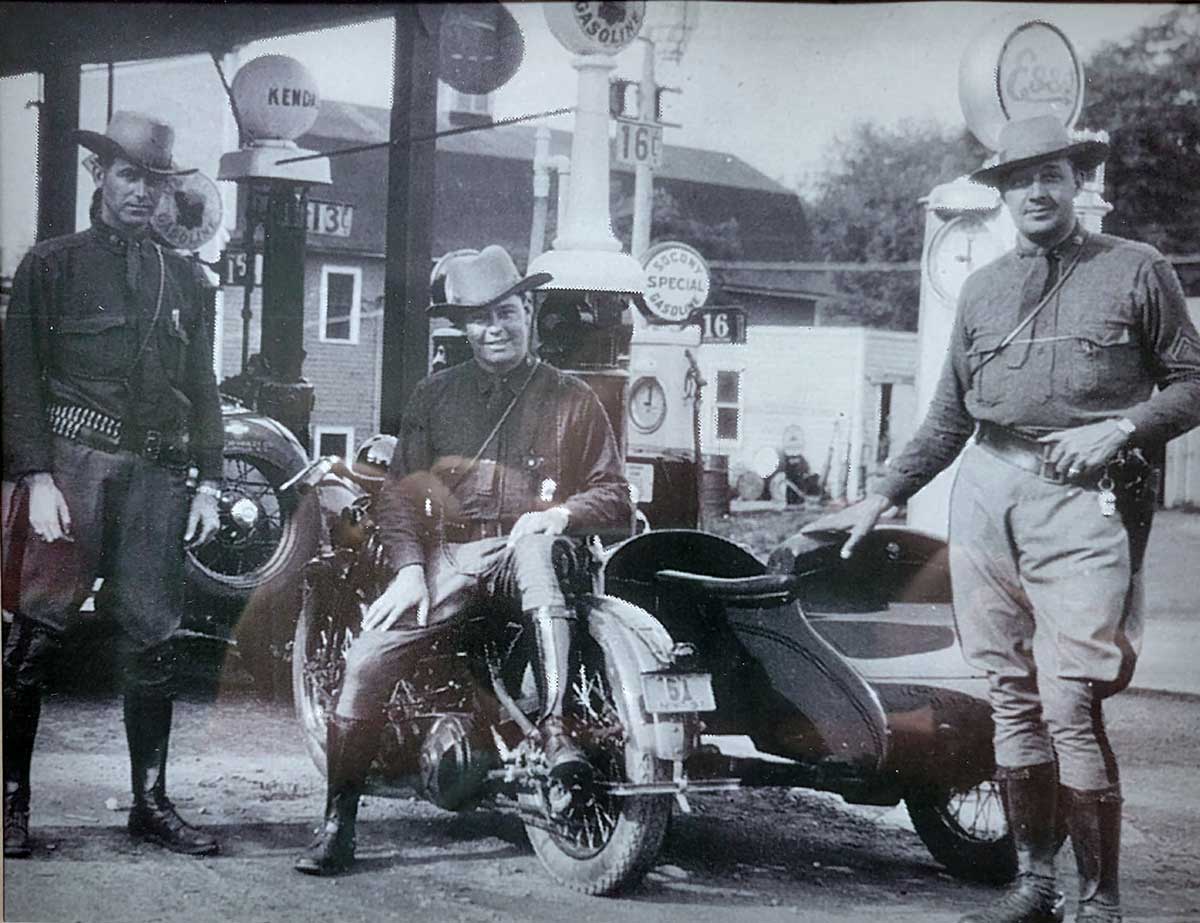 1931...13 and 16 cents a gallon !
1931...13 and 16 cents a gallon !
 1933 issue motorcycle with 4 digit number. Embossed steel.
1933 issue motorcycle with 4 digit number. Embossed steel.
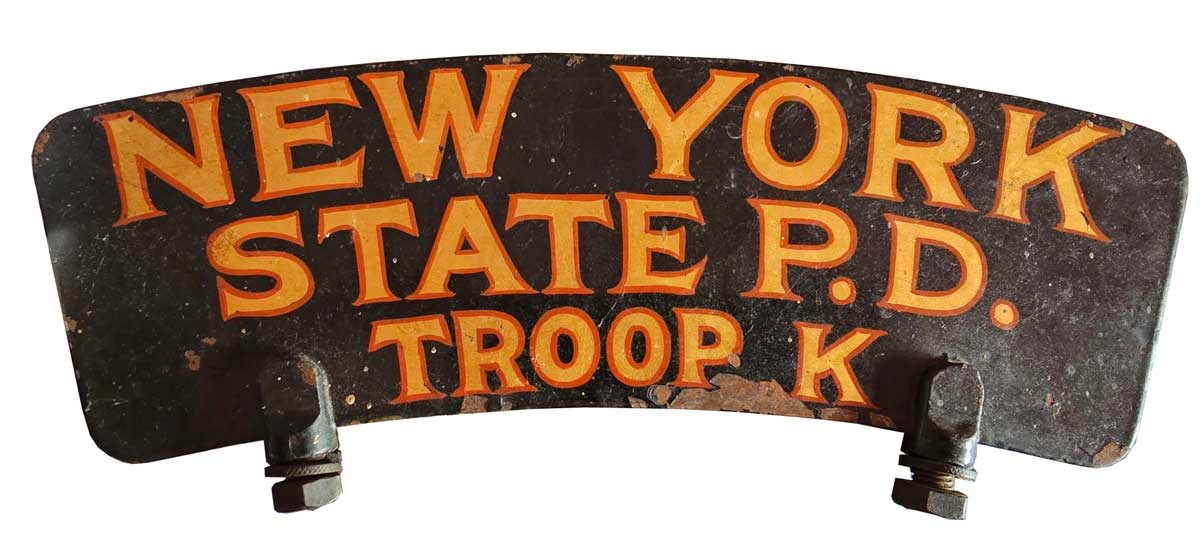 (Courtesy Chris Fretta)
(Courtesy Chris Fretta)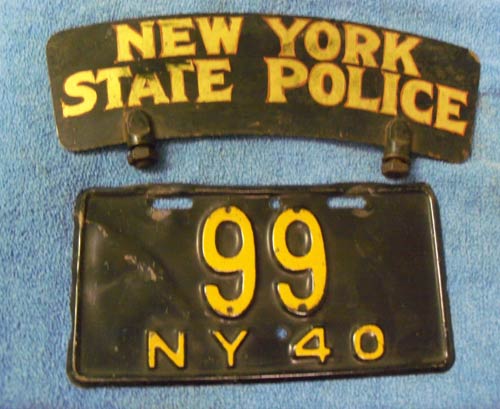








 1965 motorcycle issue.
1965 motorcycle issue.
 Late 1960's motorcycle issue.
Late 1960's motorcycle issue. Late 1960's era motorcycle issue.Embossed steel.
Late 1960's era motorcycle issue.Embossed steel. 1973-1986 motorcycle issue.
1973-1986 motorcycle issue.
 Personalized private motorcycle license plate for NYS Trooper assigned SP motorcycle #55 seen above.
Personalized private motorcycle license plate for NYS Trooper assigned SP motorcycle #55 seen above.
 1995-current motorcycle issue.
1995-current motorcycle issue. 
 2022-current motorcycle issue. Silkscreened aluminum
2022-current motorcycle issue. Silkscreened aluminum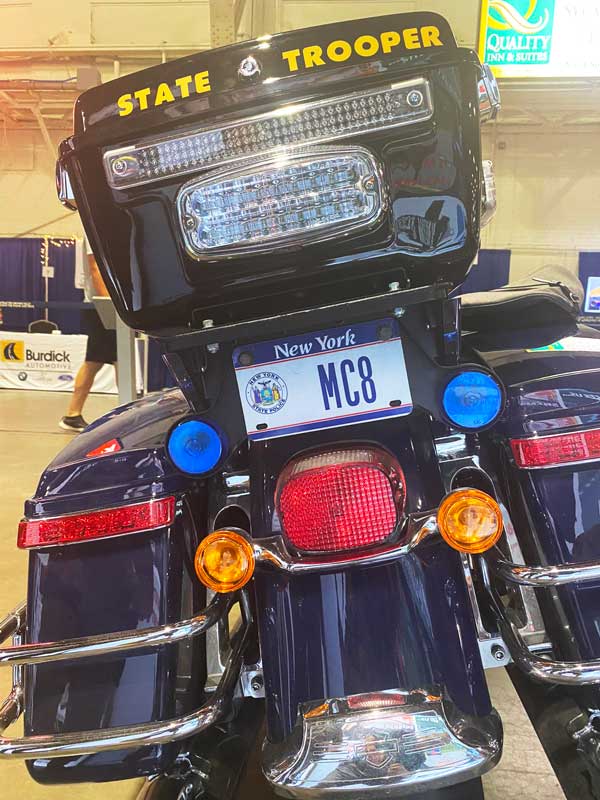

 Current-issue (2023)
Current-issue (2023)  Current-issue (2023)
Current-issue (2023)Some special issue license plates with respect to the New York State Police have been issued both officially and unofficially. Here are some examples below:
 Old style NYSP license plate topper.
Old style NYSP license plate topper. 1973-1984 error.
1973-1984 error. Unknown type. 1984-1986 layout and color scheme, however with 1986-onward thin embossed dies and DSP prefix.
Unknown type. 1984-1986 layout and color scheme, however with 1986-onward thin embossed dies and DSP prefix.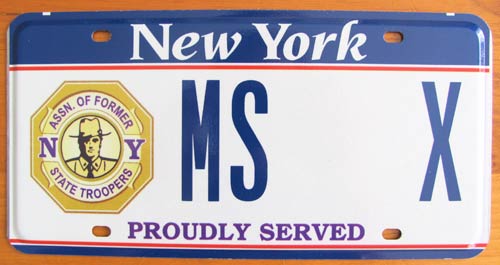 Current issue Association of Former New York State Troopers. Personal use.
Current issue Association of Former New York State Troopers. Personal use.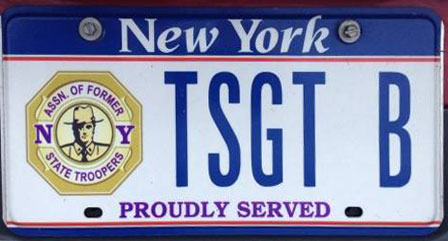 Current issue Association of Former New York State Troopers. Personal use.
Current issue Association of Former New York State Troopers. Personal use. Older issue- Association of Former New York State Troopers. Personal Use. Commercial base plate.
Older issue- Association of Former New York State Troopers. Personal Use. Commercial base plate. Current issue- Association of Former New York State Troopers.
Current issue- Association of Former New York State Troopers.  Custom NYSP plate made for restored 1973 NYSP Plymouth Fury .
Custom NYSP plate made for restored 1973 NYSP Plymouth Fury .
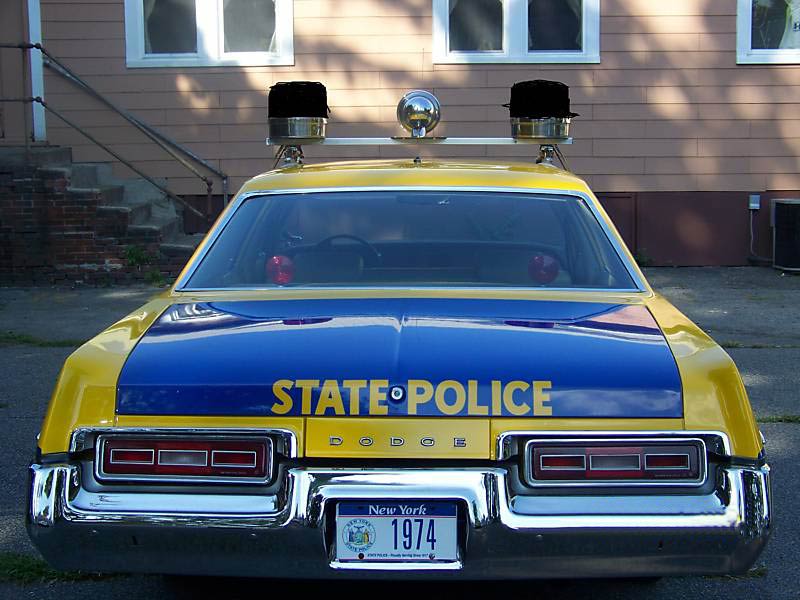

 Special Order NYSP license plate used as "Cubicle Marker"
Special Order NYSP license plate used as "Cubicle Marker" Flip-side of plate seen at left. Magnets affixed to back side of plate to mount on face of metal desk.
Flip-side of plate seen at left. Magnets affixed to back side of plate to mount on face of metal desk. Circa 1990's promotional "booster" plate.
Circa 1990's promotional "booster" plate.  Circa 1990's-2000's promotional "booster" plate.
Circa 1990's-2000's promotional "booster" plate.  90th Anniversary Souvenir.
90th Anniversary Souvenir.  95th Anniversary Souvenir issue.
95th Anniversary Souvenir issue. 100th Anniversary Souvenir.
100th Anniversary Souvenir.